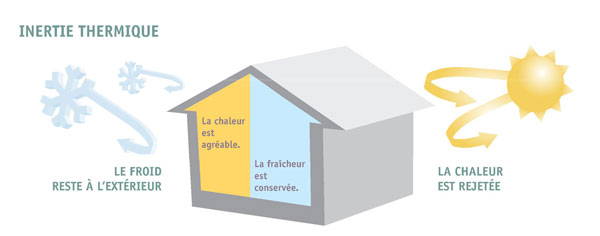The GBE System®:
- Overcomes regulatory challenges related to RE2021 (French Thermic Regulation) in the building sector.
- Obtains excellent airtightness and enables transition from A0 format to A5 position. As such, the values required by the BBC (1m3/m2.h under 4Pa) and Passivhaus (n50=0.6vol/h under 50Pa) labels can be acquired for collective housing.
- Ensures an envelope quality compliant with requirements from energy performance labels.
Resistance to ageing and environmental advantages.
Concrete is especially resistant to all types of hazards and loading. Compared with all other materials, concrete best withstands ageing, weather, pollution, impacts, biological degradation (mould and fungal growth, etc.) and fire.
Energy consumption
The wall’s integral insulation provides excellent heat resistance. This good level of insulation also helps ensure surface temperatures inside the wall are similar to temperatures inside the building; this enhances thermal comfort and eliminates the risk of fungal growth or condensation.
Thermal inertia
The GBE System® means the inner 16 cm concrete wall can be accessed to both store and release energy. As such, a ‘very high’ inertia type can be factored into RT2012 calculations. Good thermal inertia contributes to an excellent level of thermal comfort and eliminates energy consumption spent using active cooling systems.
Another benefit of a system with heavy inner and outer walls lies in its advantageous dynamic behaviour (EN-ISO 13786 compliant). Internal temperature peaks related to sunlight on outer surfaces will be greatly reduced and spread out over time. This helps enhance thermal comfort and reduces the risk of overheating. (EN ISO 13786)

Control of thermal bridges and airtightness
Traditional construction methods entail singular points such as facade-recess, facade-flooring connections, etc. and acroterion. They form thermal bridges, which are synonymous with significant additional energy losses. However, with the GBE System, the value Ψ for the intermediate facade-floor connection of 20cm is 0.07W/m.K, compared to 0.99W/m.K in traditional construction systems. The system offers improved performances with regard to thermal-induced rupture.
The GBE System® makes it possible to eradicate such thermal bridges, which is crucial for low-energy consumption buildings. The system also increases thermal comfort and eliminates the risk of mould and condensation.
Since concrete is an airtight material, the cast-in-place system makes it possible to construct opaque walls with an excellent level of airtightness.
The GBE System® offers an envelope quality compliant with requirements from energy performance labels and standards.